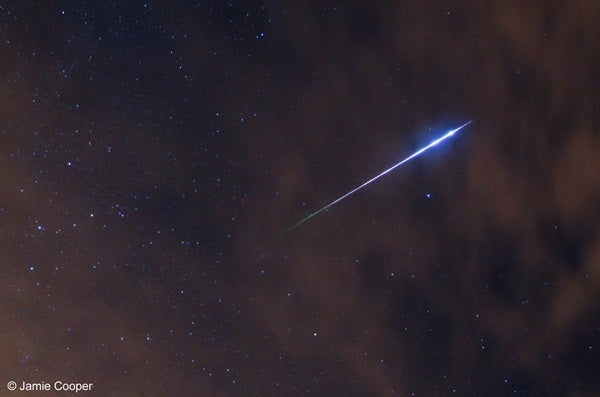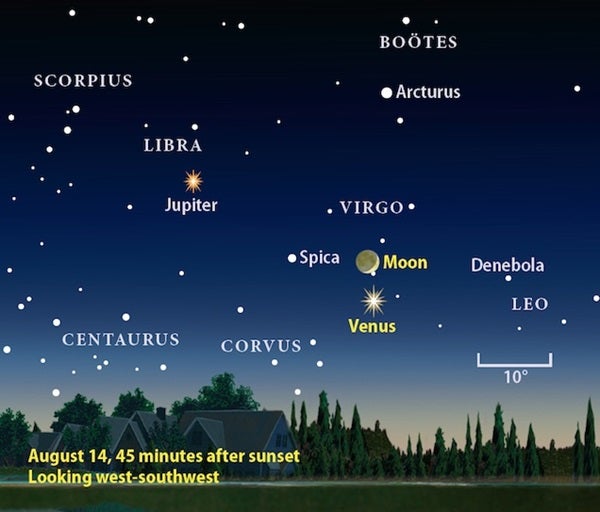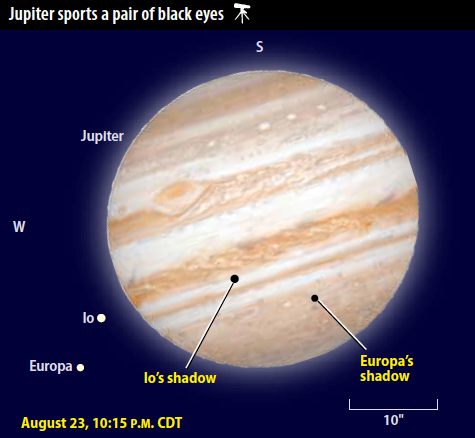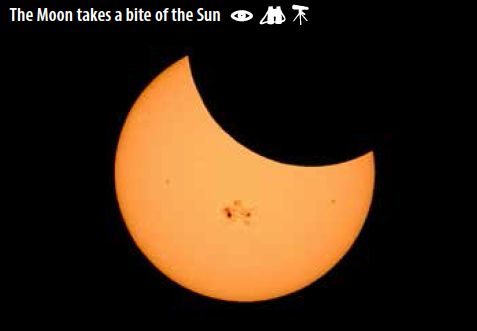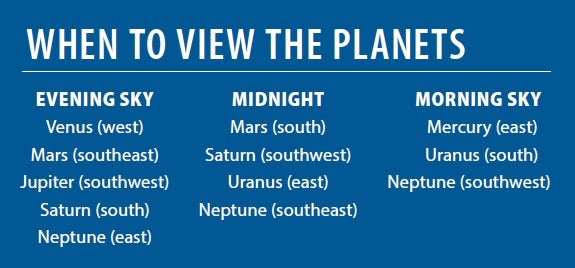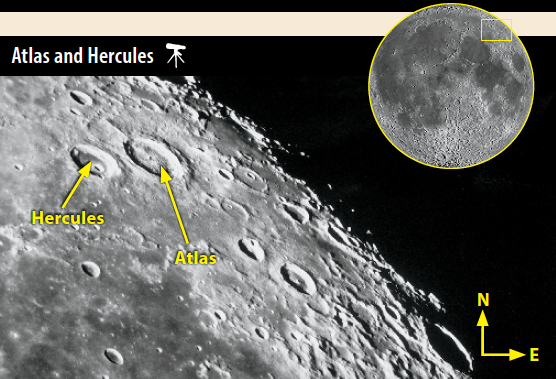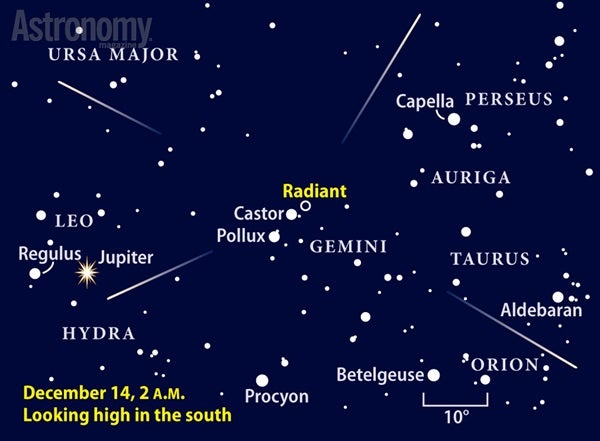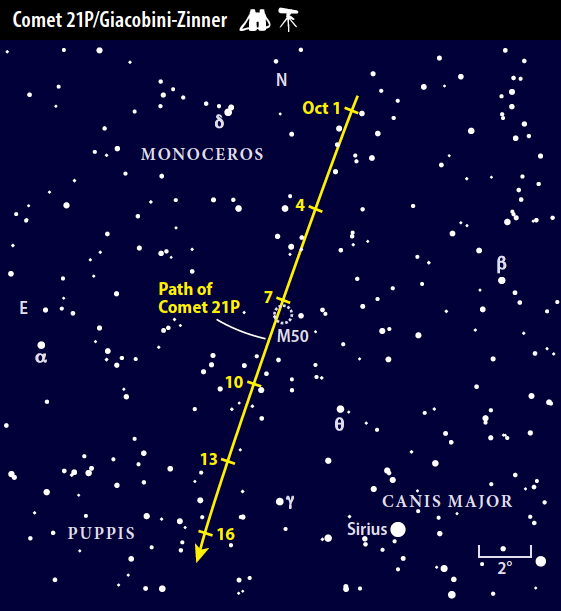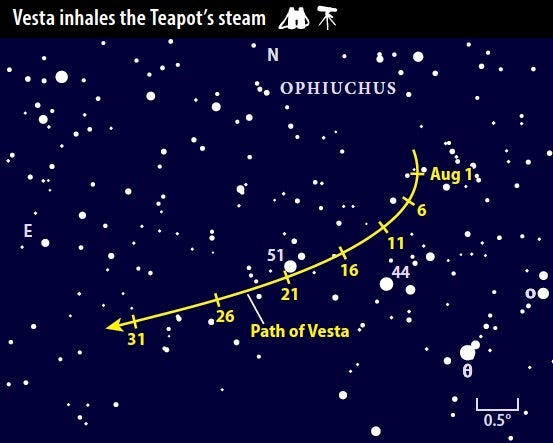If you look west as twilight deepens, you can’t miss Venus. Earth’s neighbor brightens from magnitude –4.3 to –4.6 this month and appears prominent a half-hour after sunset. The planet moves eastward against the backdrop of Virgo, pulling closer to 1st-magnitude Spica. It approaches within 1.3° of this star at month’s end.
Northern Hemisphere observers won’t see Venus climb high. From 40° north latitude, the planet stands 10° above the western horizon an hour after sundown August 1. It appears 2° lower when the waxing crescent Moon passes by on the 13th and 14th. Luna appears 10° to Venus’ right on the 13th and 7° above the planet the following night.
Venus reaches greatest elongation August 17, when it lies 46° east of the Sun. You might think the planet would appear highest then, but you’d be wrong — Venus stands only 7° high an hour after sunset. The problem is that the ecliptic, the apparent path of the Sun and planets across the sky, makes a shallow angle to the western horizon after sundown in late summer. How much difference does this make? Venus appeared more than twice as high in early June when it was only 35° from the Sun.
Despite its low altitude, Venus sports two distinct advantages over its late spring appearance. Not only does it shine brighter than it did in early June, but it also looks more appealing through a telescope. In August, the planet’s diameter grows from 21″ to 29″ while its phase wanes from 57 to 40 percent lit.
Jupiter lies in Libra near magnitude 2.8 Zubenelgenubi (Alpha [α] Librae). The giant world begins the month 1.4° northwest of this star, but the planet’s eastward motion carries it to a point 0.6° due north of it on the 14th. By month’s end, Jupiter lies 1.9° east of Alpha. Shining at magnitude –2.0 in mid-August, the planet appears nearly 100 times brighter than the star.
Plan to observe Jupiter through a telescope while it lies highest near the end of twilight. The planet’s large apparent size (36″ at midmonth) affords great views of its dynamic atmosphere. Two dark equatorial belts, one on either side of a brighter zone that coincides with Jupiter’s equator, stand out. Finer details come into view through larger scopes or during moments of steady seeing.
As you view Jupiter, you’ll also see up to four moons arrayed around the planet. The jovian satellites change positions noticeably within an hour or two, but the most exciting times to observe are when one of them passes in front of the planet and casts its shadow on the cloud tops.
Dozens of such events occur in August, but perhaps the most appealing for North American observers happens on the 23rd. That evening finds both Io and Europa in front of Jupiter after darkness falls along the East Coast and during twilight across the Midwest. Io’s shadow first touches the jovian cloud tops at 10:02 p.m. EDT, 19 minutes before Europa itself moves off the planet’s western limb.
Europa’s shadow appears on the planet’s eastern limb starting at 10:34 p.m. EDT. For the next 97 minutes, both shadows transit Jupiter’s disk. (From eastern North America, the planet sets during the early part of this double shadow transit and prime viewing locations shift farther west.) Io moves off Jupiter’s limb at 9:59 p.m. CDT, while the shadows lift back into space between 9 and 10 p.m. PDT.
Of course, Saturn looks even more stunning through a telescope. The planet’s disk spans 18″ while the rings extend 40″ and tip 27° to our line of sight. The large tilt affords dramatic views of ring structure. Even the smallest scope reveals the dark gap that separates the outer A ring from the brighter B ring.
Small instruments also show several moons. Titan is the biggest and brightest; its 8th-magnitude glow shows up easily through any scope. The satellite’s distance from Saturn ranges from 1.3′ when it lies due north or south to 2.9′ when it is farthest east or west.
Three 10th-magnitude moons — Tethys, Dione, and Rhea — show up through 4-inch and larger instruments. All three circle Saturn inside Titan’s orbit. Distant Iapetus proves more challenging. It appears as an 11th-magnitude dot 1.7′ south of Saturn on August 8. Although it doubles in brightness by the time it reaches greatest western elongation on the 28th, it then lies 8.8′ from the planet and will be harder to spot so far from its parent body.
As nice as Venus, Jupiter, and Saturn are, Mars is the star of the planetary world in August. The Red Planet reached its peak during July’s final week, and the view in early August hardly suffers. On the 1st, it shines at magnitude –2.8 and its disk spans 24″. By the 31st, however, Mars
This region remains visible all night in early August, climbing highest in the south shortly before 1 a.m. local daylight time. It reaches the same position by 10:30 p.m. in late August. Mars peaks at an altitude of about 25° from mid-northern latitudes; the finest views through a telescope come within two hours of this peak.
Features on Mars appear best when they lie near the center of its disk. For observers in North America, Aurorae Sinus stands front and center on August’s first few evenings; Sinus Meridiani takes center stage on the 9th and 10th; Syrtis Major and Hellas follow suit from the 16th to the 18th; and Mare Sirenum takes over on the 30th and 31st.
Neptune rises by 10 p.m. local daylight time August 1 and during twilight by month’s close. But the best views will come after midnight. You’ll need binoculars or a telescope to track down the planet, which glows at magnitude 7.8 in eastern Aquarius. Use 4th-magnitude Phi (ϕ) Aquarii as a guide. Neptune lies 1.4° west-southwest of this star on the 1st and drifts 0.7° farther away by month’s end. A telescope reveals the planet’s blue-gray disk, which measures 2.4″ across.
Uranus trails three hours behind Neptune. The closer planet won’t tax your observing skills as much because it shines at magnitude 5.8 — bright enough to see with the naked eye under a dark sky and an easy binocular object after it climbs high in the southeast in the hours before dawn. Uranus lies in Aries, 12° south of Hamal (Alpha Arietis). Three 6th-magnitude stars lie within 2° of the planet. Use a telescope to distinguish Uranus, which shows a 3.6″-diameter disk and a distinctive blue-green hue, from the pointlike stars.
The last week of August finds Mercury in the predawn sky. The planet reaches greatest elongation 18° west of the Sun on the 26th. But unlike August evenings, the ecliptic angles nearly straight up from the eastern horizon before dawn, and Mercury stands 8° high 45 minutes before sunrise. When viewed through a telescope, the magnitude –0.2 planet spans 7″ and appears 43 percent lit.
Last August brought perhaps the most watched total solar eclipse in history. On August 11, 2018, observers in northern Canada, northern Europe, and parts of Asia can witness a partial solar eclipse. With a safe solar filter, viewers in these regions can watch the Moon pass in front of the Sun. From Beijing, the Moon covers one-third of our star’s diameter just before sunset.
A southern treat at First Quarter
The Moon slinks low across the southern sky on summer evenings. It often shows a color that can range from pale yellow to orange. The warm color arises because its light takes a longer path through Earth’s atmosphere, which scatters out shorter wavelengths, and occasionally passes through smoke from late summer forest fires.
Plan to target Luna on the evening of August 17. The First Quarter Moon then displays a breathtaking series of seas in its north. After enjoying these lava-filled basins, scan southward along the craters that line the terminator — the dividing line between lunar day and night that nearly bisects the Moon this evening.
The large crater Maurolycus resides in the southern third of the lunar disk. Named after the 16th-century Italian mathematician Francesco Maurolico, who disagreed with Copernicus’ theory of a Sun-centered solar system, the crater spans 71 miles. The impact that carved out this beauty fractured the lunar crust. Lava later seeped up and paved the floor around its central peaks. The event partially wiped out a crater to its immediate south and one to the northwest.
More recent impacts left sharper craters and softened earlier ones. The freshest are the small craterlets on Maurolycus’ floor. Can you figure out the sequence of impacts that created the group on the crater’s northwestern edge? Your observations on the 17th and subsequent evenings will help set the timeline straight. A similar story plays out on the crater Gemma Frisius a short hop to the north.
As the Moon approaches its Full phase on the 26th, notice that a ray from Tycho Crater crosses Maurolycus. Use high magnification to pick out this subtle stripe.
Most observers rank the Perseid meteor shower as the best of the year. This annual treat offers a consistently high rate of meteors, produces a high percentage of bright ones, and takes place in August when nice weather is common.
And this year promises the best display in three years. The shower peaks the night of August 12/13, less than two days after New Moon, so our satellite won’t shed any unwanted light into the night sky. The best views will come before dawn on the 13th, when the radiant — the point in Perseus from where the meteors appear to emanate — climbs highest. Observers under a dark sky can expect to see an average of between one and two meteors per minute.
Comet 21P/Giacobini-Zinner loops from beyond Jupiter’s orbit to just outside Earth’s. This circuit brings it into the inner solar system every 6.6 years, though some returns produce better displays than others. Fortunately, this should be one of the comet’s best.
If predictions hold, Comet 21P should reach 9th magnitude in August. To see it well, you’ll need a 4-inch or larger telescope and a dark-sky site. The comet moves from Cassiopeia the Queen into Camelopardalis the Giraffe this month. Although this region is circumpolar north of 30° north latitude, it climbs highest after midnight. Your best views will come when the Moon is gone from the morning sky during mid-August. Astroimagers won’t want to miss the comet when it passes through the photogenic region of the Heart and Soul nebulae (IC 1805 and IC 1848, respectively), from the 15th to the 18th.
Comet 21P should sport a well-defined eastern flank. This is where the solar wind pushes on dust ejected from its icy nucleus. The comet typically develops a short gas tail, too. High power should reveal a bright spot at the comet’s center — the so-called false nucleus — where dust hides the true nucleus from view.
After viewing August’s four bright evening planets, how about a low-stress diversion? This is a great time to watch asteroid 4 Vesta shift from night to night as it crosses one of the emptiest zones near the Milky Way’s heart.
Whether you use binoculars or a telescope, this main belt object should be simple to find. With only a handful of nearby stars brighter than our target, the chart below will take the guesswork out of identifying 7th-magnitude Vesta from the distant suns.
The asteroid lies in southern Ophiuchus. To find it, zero in on this region’s brightest star, magnitude 3.3 Theta (θ) Ophiuchi. Then, shift your view northeast to where the chart shows you Vesta’s location. Alternatively, from a dark-sky site, you can jump to the spot on the southern flank of the star cloud dubbed the “Teapot’s steam.”
Like all solar system objects, Vesta changes position relative to the background stars as it orbits the Sun. But the asteroid’s motion this month is quite slow. Although its night-to-night movement is obvious, you’ll be hard-pressed to see it shift position during a two-hour observing session. Your best chance comes the evenings of August 20 and 21. Vesta then skims less than 10′ south of the 5th-magnitude star 51 Oph.

